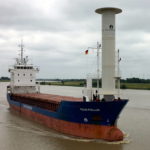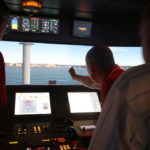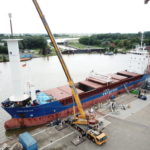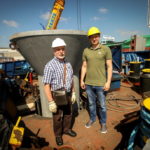After years of planning and weeks of conversion works, »Fehn Pollux« of Leer-based Fehn Shipmanagement now operates with a Flettner rotor. The first voyages show good results. HANSA takes a look at the development of the project
25 May: The ship is on its way »home«. It will be the first ship to be equipped[ds_preview] with the prototype of a newly developed sail propulsion system, the EcoFlettner.
Day 5: The work is progressing very well: A crane has lifted the prepared foundation for the rotor onto the ship. It is anchored, aligned and welded to the deck and underlying structure.
Day 7: The control console for the EcoFlettner is also already on board. The EcoFlettner can be operated manually or automatically with the console. It rotates with a maximum of 280 times per minute. But that doesn’t always make sense, depending on wind speed and other parameters, as the rotor itself uses electrical energy for its movement. Therefore, an algorithm takes over the calculations. In automatic mode the system adjusts the speed and direction of rotation of the rotor according to wind speed and direction. That will be the normal mode of operation on board. The console also displays relevant data, such as rotor temperature and wind speed.
Day 9: There is still a lot to do: The rotor needs a power connection. The control console on the bridge also needs to be connected to the rotor. This requires many meters of cable.
Day 12: The work continues, also for the crew. The men are trained at the ship handling simulator of Nautitec. Among other things, it’s about getting used to the altered field of vision, as the rotor can obscure small objects. The steering characteristics also change a little. The crew can familiarize themselves with the ship’s behaviour in hybrid operation and reduce the main engine power according to the rotor performance.
Day 14: The wind blew with windforce of 3 to 4 Bft., in gusts up to force 5. The rotor was lifted with a crane onto the vessel. The workers fixed it with 36 hexagonal bolts and applied sealing compound at the seams to protect the electronics inside the EcoFlettner against moisture. Before these steps, the foredeck was reinforced, new cables were laid and the control console was installed on the bridge.
Day 16: The so called yard inclining test to determine the mass of the ship and its centre of gravity is conducted. This is required by rules for newbuildings and after major conversions in shipbuilding. At the beginning of the test the displacement which equals the mass is determined by reading off precisely the draft scales of the ship. Then a calibrated weight is shifted on deck from one side to the other, usually by crane. The resulting angle of inclination or heeling angle is measured using a thread pendulum or another precise instrument. Shifting moment and heeling angle yield the vertical height of the centre of gravity by calculation. This value is needed to determine the ship’s stability. The test was conducted in the presence of classification society DNV GL. They were happy with the results and gave green light to sail.
Day 24: »Fehn Pollux« left Leer for sea trials. The three-week shipyard period was thus completed. The team on board tested all systems and checked the manoeuvrability. Project partner Professor Michael Vahs from University of Applied Sciences Emden/Leer says: »The rotor works as planned and the ship behaves as calculated«. The automatic control system works well and sets the optimal speed for the rotor according to the wind conditions. The crew does not need to take any active part in the operation. The on-board computer stores all data, which will be analyzed and evaluated by the project team ashore. »We are very pleased with the performance of the Flettner rotor and that of the ship,« said project coordinator Ralf Oltmanns from Leer-based Mariko after completing the test series in the North Sea. »After three intense weeks, we are very happy to see our ship back in action,« said Matthias Hesse, Managing Director of Fehn Ship Management. The rotor works as promised and the ship behaves as calculated. Evaluation is planned to take place at the end of the year.
20 July: »Fehn Pollux« is alongside in Great Yarmouth/UK. After three weeks in service, first experiences show, that the sailing device is definitively saving fuel.


























